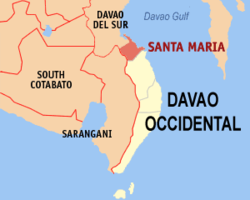Santa Maria, Davao Occidental
| Santa Maria | ||
|---|---|---|
| Municipality | ||
|
||
 Map of Davao Occidental with Santa Maria highlighted |
||
| Location within the Philippines | ||
| Coordinates: 06°33′N 125°28′E / 6.550°N 125.467°ECoordinates: 06°33′N 125°28′E / 6.550°N 125.467°E | ||
| Country | Philippines | |
| Region | Davao Region (Region XI) | |
| Province | Davao Occidental | |
| District | Lone District of Davao Occidental | |
| Barangays | 22 | |
| Government | ||
| • Mayor | Rudy Mariscal | |
| Area | ||
| • Total | 175.00 km2 (67.57 sq mi) | |
| Population (2015 census) | ||
| • Total | 53,671 | |
| • Density | 310/km2 (790/sq mi) | |
| Time zone | PST (UTC+8) | |
| ZIP code | 8011 | |
| IDD : area code | +63 (0)82 | |
| Income class | 2nd municipal income class | |
| 118604000 | ||
| Electorate | 30,036 voters as of 2016 | |
Santa Maria is a 2nd class municipality in the province of Davao Occidental, Philippines. According to the 2015 census, it has a population of 53,671 people.
The municipality, located on Mindanao Island, is about 40 kilometres (25 mi) north-west of province capital municipality of Malita and about 1,023 kilometres (636 mi) south-south-east of Philippine main capital Manila. The noted features of Santa Maria is the Mt. Cuiawa, standing about more than a hundred-meter above sea level. And at the foot of this mountain, the Municipal Hall where it is located.
Santa Maria is politically subdivided into 22 barangays.
Taga-Caulo Tribe has a rich culture, but some of them were common to the other tribes, like Bagobo, Kalagan, B'laan and Mandaya.
Caulos spend their time to farming and hunting. Female enjoys much in grooming each others hair, removing all kinds of lice (kuto) and it's egg (lusa). When females reached at age of thirteen years, they are subject now for rituals, particularly on blackening their teeth by the used of burned iron semi fluid taken from the axe now and then until all their teeth is blacked. And also, it is the time that they are ready for marriage. Betrothed is the form of their marriage. groom give the dowry to the bride's parents, usually agong, kamagi(necklace) fighting horse and farming animals.
Ancient Caulo use upland rice, crops like kamote, dangay (cassava), and lűbok(banana), and leafy vegetables. They make their own coffee and sugar. Pangot is a process of catching a fresh water shrimps (Ongkok or Ulabang)and paitan (fish) using alawa (a net).
The native dance is Ǜdol (ao-deal) that uses a stick as the source of sounds and beats.
Timanum ( tee - mah - noom ) is the name of their god, the creator, the giver of life and good harvest.
Municipal officials 2013-2016:
...
Wikipedia


